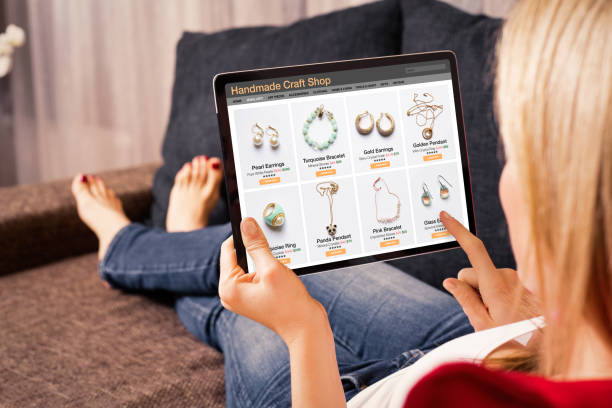Congratulations! You’ve decided to start an Etsy store. It can be a very exciting, creative decision, but also a scary one. There are so many things you need to do as a handmade seller on Etsy and they include photos, titles, tags, descriptions, price points, and more. This can be difficult if you are a maker and don’t have much experience with this. Worry no more! I’ve put together this beginner guide on How To Open an Etsy Store to Start a Handmade Business.
Choose a name.
The name you choose for your store is one of the most important decisions when it comes to your Etsy shop. Your shop name should be memorable, easy to spell and pronounce and stand out from the crowd. You want people who visit Etsy looking for handmade items to be able to find yours!
Here are some tips on picking a name:
- Choose a name that’s easy to spell and pronounce. A lot of people search by typing in what they are looking for into Google or another search engine so it’s important that they can easily find yours if they type something wrong like “Etsy” instead of “etsy.”
- Make sure no one else has chosen that exact same word as their shop. There are only so many words in English so if somebody else has already used yours then pick something different!
- Make sure your brand stands out from all others by choosing something unique but memorable at the same time; think about how memorable Coca-Cola’s branding campaign was over 100 years ago!
Determine your brand.
As you begin to develop your brand, it’s helpful to remember that Etsy customers are looking for something unique. They want something that can’t be found anywhere else. In order for this to happen, you need to create a brand that stands out from the crowd and makes people feel special when they buy from you.
What is a brand? A brand is a perception of identity — it’s what people think about your business when they see or hear about it (whether this perception is positive or negative). Your business name, logo, and website should all work together in order to create an overall experience that matches the impression customers have of your product.
Related: How to Register Your Trademark for Your Brand
Define your product line.
Your product line must be defined before you open an Etsy store for a handmade brand. Your product line includes the following elements:
- List all the products you want to sell. If you can’t think of any, try some brainstorming exercises. If there are certain items that are always in demand at craft fairs, or if there was a trend in recent history that inspires you, capitalize on that!
- Define how you want to brand your products. Do they have a specific look and feel? Will the packaging be beautiful and luxurious? Are these just things for everyday use, or will people be buying them as collector’s items? You don’t need to decide this immediately—you can always adjust it later if necessary—but having an idea from the very beginning will help inform every other aspect of starting an Etsy store so keep this in mind as we move forward with this guide.
- Define how you want to market your products when selling them online through Etsy’s marketplace platform (and/or any other platforms). For example: if someone searches for “wallet” on Google Images today and sees one particular design from yours by chance while browsing through hundreds (thousands?) more options available worldwide then chances are high they’ll end up buying it instead because they clicked on it first! So pick one thing those people may search for instead like “wallet chic.” The goal is simply knowing which keywords relate most closely related content relative importance within its genre category which then leads us into the next step…
Review the Etsy Seller Handbook.
There are a few things to keep in mind when setting up your Etsy shop. First, you need to create an account with Etsy. Then you have the option of creating your shop and listing products right away or giving yourself time to get organized before getting started. If you choose the former, it’s important that you read over the rules for opening an Etsy shop so that everything is done correctly from day one.
The Seller Handbook helps guide new sellers through all aspects of opening an online store on Etsy — from what type of items are allowed on the site, how pricing works, and even how shipping should happen (and what happens if something goes wrong).
Create your shop.
Etsy is an online marketplace where people can buy and sell handmade products. To create your shop, sign up for a free account at www.etsy.com and then click the “Start your own Etsy shop” button in the top right corner of any screen on the site. On this page, you’ll be able to choose from different plans—it’s cheaper if you open a store with fewer items than if you open one with multiple categories or multiple shops (which would allow you to sell in multiple locations).
Once your account has been created, click “Add new item” under Shop Manager in the menu bar at the top left side of your screen (this will also appear after selecting “Settings” from within Shop Manager).
Craft your listings.
There are several components to a listing, and each one is important for your store’s success.
- Listing Format: This is the overall layout of your listing, including the title and description. Your Etsy shop will have its own custom theme that you can customize with fonts and colors, but there are some general rules about how it should be laid out.
- Listing description: The description is where you’ll go into more detail about what makes this item special. It should answer questions like “what is this item made from?” or “what inspired me to create it.” You should also include any details on how you’ll ship the product once it’s sold (for example, if there’s an extra charge).
- Listing Title: This is probably one of the most important parts of your listing! The title needs to be short enough that someone looking at search results will notice it quickly (and still tell them everything they need), while also being descriptive enough that people know what they’re getting before they click through. For example: “Bamboo-Cotton Towel Set” vs “Handmade Bamboo Cotton Towel Set”. You can use words like “handmade” or “eco-friendly” in your titles as long as it fits naturally within them; if those words aren’t part of what makes these items special or differentiates them from other products out there then don’t include them!
Set a pricing strategy that works for you.
Pricing is a delicate balancing act. You want to charge enough that people are willing to pay for your products, but not so much that they won’t buy from you. It’s easy to think about how much other people charge for similar products and base yours on that—but this strategy doesn’t take into account how different your product is from theirs, or what experience should be included with it.
To figure out the best price for your beautiful handmade items, start by looking at how much you cost them: how much did it cost in materials? What was your hourly rate for labor? Then consider if there are any extra costs involved—for example, do you have packaging costs or shipping fees? Once you know all of these, add up all of the numbers together and divide by 100%. This will give you an average per-unit cost (which is what people will see when they look at your product page). If this number seems too high, try reducing it; if it seems too low (and nobody buys anything), increase it until sales improve!
Grow and manage your business.
Once you’ve created your Etsy shop, you’ll want to focus on growing and managing your business at a steady pace. Etsy has a number of tools that can help with this. For example:
- Analytics & Insights will give you insights into how people are finding and buying from your store, including the most popular searches that brought them there. You’ll also be able to see which products are selling the best and view reports on key metrics like page views, buyer behavior, and more.
- Fulfillment allows sellers who offer shipping services to print out labels right from their computer or mobile device as well as process orders through a third-party company (like Stamps).com—or even via PayPal if they don’t want any extra costs involved in fulfilling orders themselves!
- Customer Service offers features such as instant messaging so buyers can reach out directly through Etsy rather than having just one email address they need contact information for (which could get lost). Other helpful tools include Feedback Management where buyers can leave comments about purchases; Reputation Management which lets merchants respond publicly if someone has left negative feedback about them; Promoted Posts where users pay for advertising space within their shops’ listings without having ads show up everywhere else online.
Conclusion
So there you have it—everything you need to know to start an Etsy store and start a handmade business. The great thing about Etsy is that it’s a platform for everyone, whether you’re already making things or just thinking about getting started. You don’t need to be a designer or an entrepreneur—you just need some great photos of your product and enough time to get started! If this post has been helpful for your own handmade business, please feel free to share it with others who might benefit from it too.



